These Homemade Armenian cucumber pickles have an uber-crunchy and tender texture, accompanied by sweet, tangy, and earthy flavors. They are incredibly easy to make and don’t require complicated and lengthy steps.
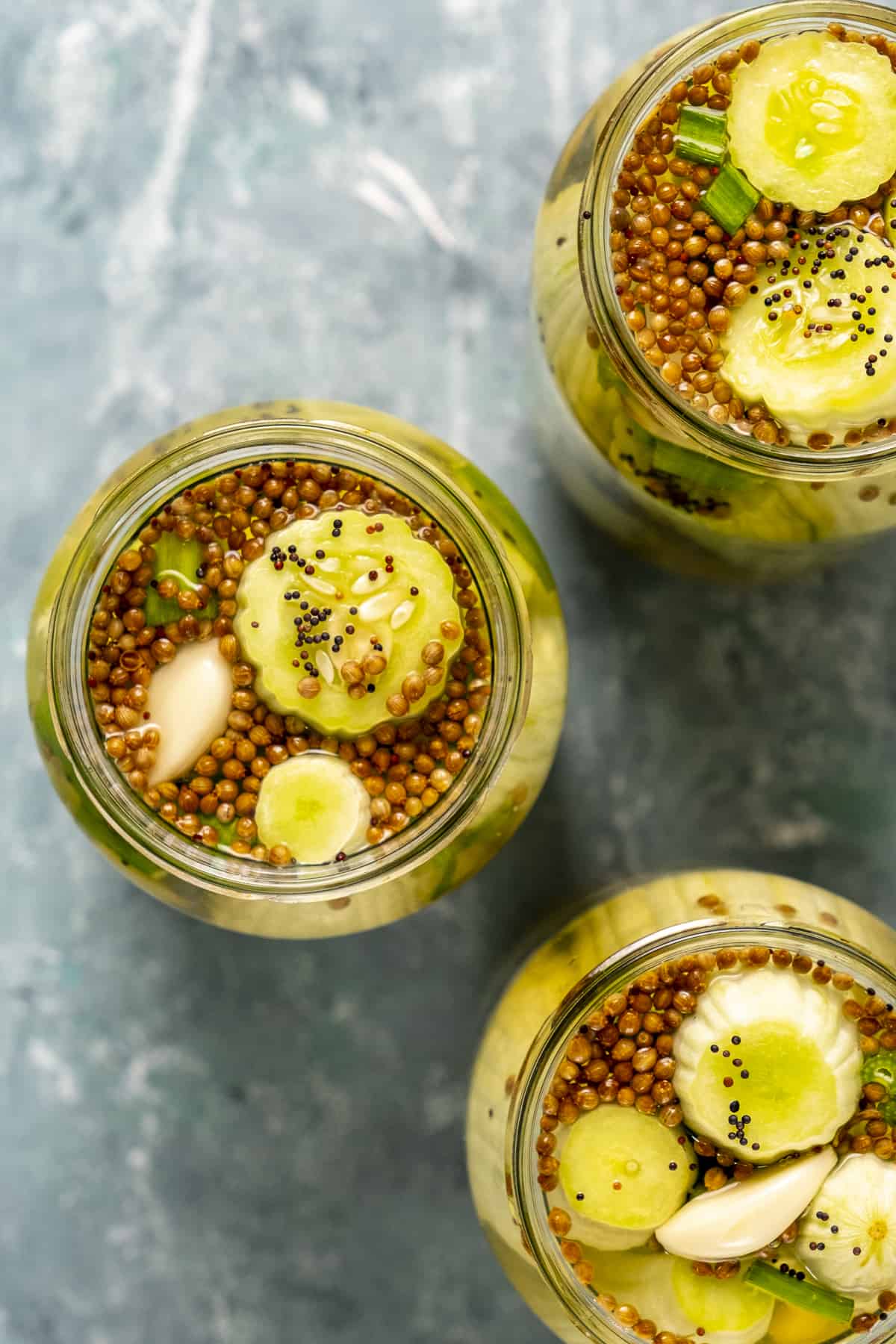
We use this pickle recipe as a base and make several pickles (aka turşu or tourshi) with veggies including Armenian cucumbers. We sometimes mix them all in a large jar and sometimes put each vegetable in separate jars. They all pair well with stews, salads, sandwiches and pasta.
Jump to:
Why Should You Make This Recipe
Pickling is the best thing to do with Armenian cucumbers. They do go great inside salads or accompanying stews. But to truly appreciate their crunchy texture and tangy-sweet flavor, you can serve them as an appetizer or side dish on their own.
If you like homemade dill pickles, we know you will love this recipe too!
The pickling process is really easy to follow.
From this basic pickles recipe, you can create thousands more!
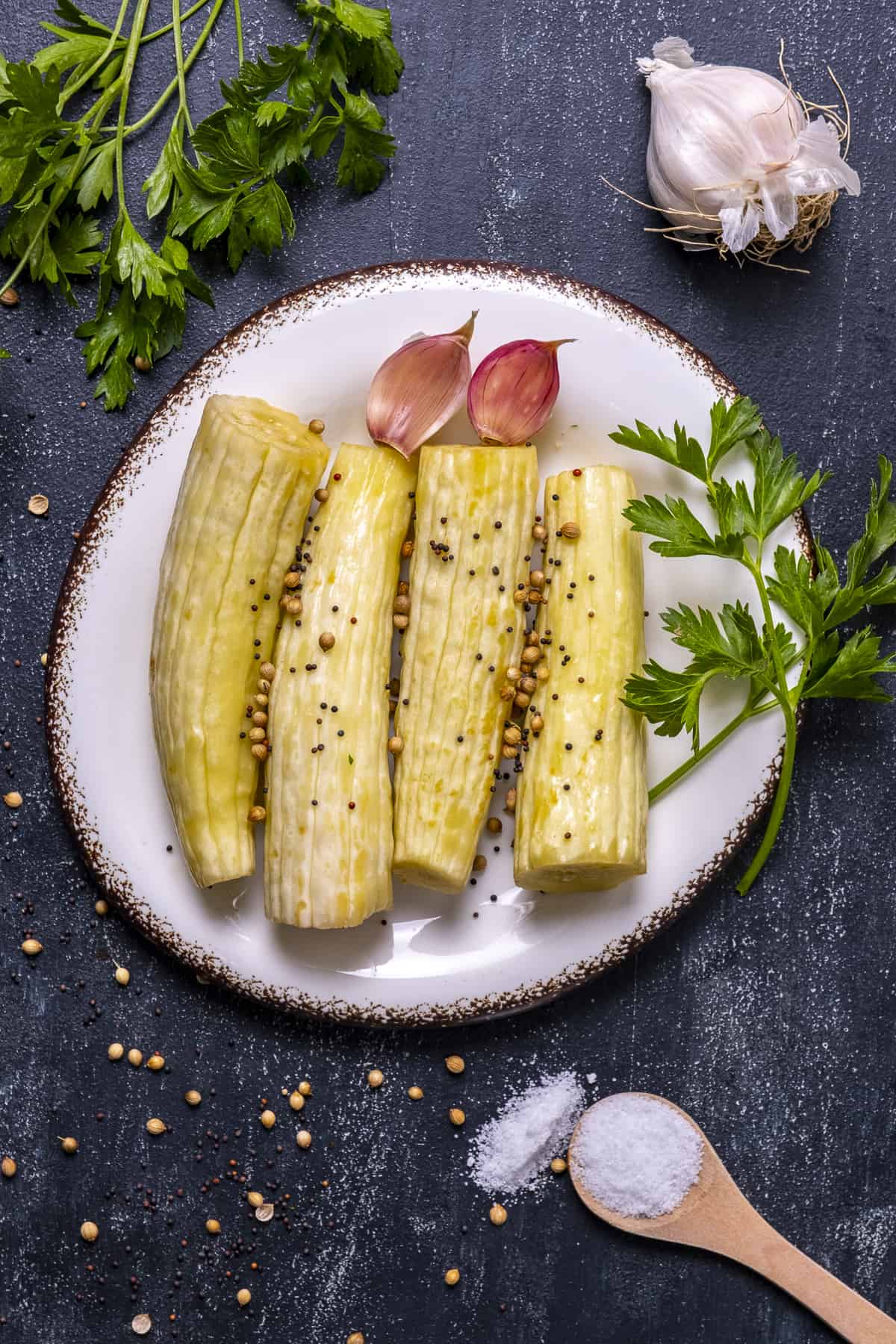
What Are Armenian Cucumbers?
Armenian cucumbers are simply a different variety of cucumbers that are commonly found in the Middle East (and by Middle Eastern grocers in Western countries). They have different names like yard-long cucumber, snake cucumber, serpent cucumber, snake melon or uri (source here).
This special type of cucumber is, however, very unique in its appearance. They can grow up to 36-inches (91 cm) long! On average though, they range between 12 to 15-inches. They are quite slender and have a textured surface and light green skin.
On the inside, they look exactly like regular cucumbers and taste like them too. They are equally healthy and low in calories.
If you don’t know what to do with Armenian cucumbers, start with pickling them.
Now, you might ask "Can you pickle Armenian cucumbers?" Yes, of course! It is the best way to preserve them. In the countries where they are grown widely, these unique cucumbers are one of the most popular vegetables to pickle.
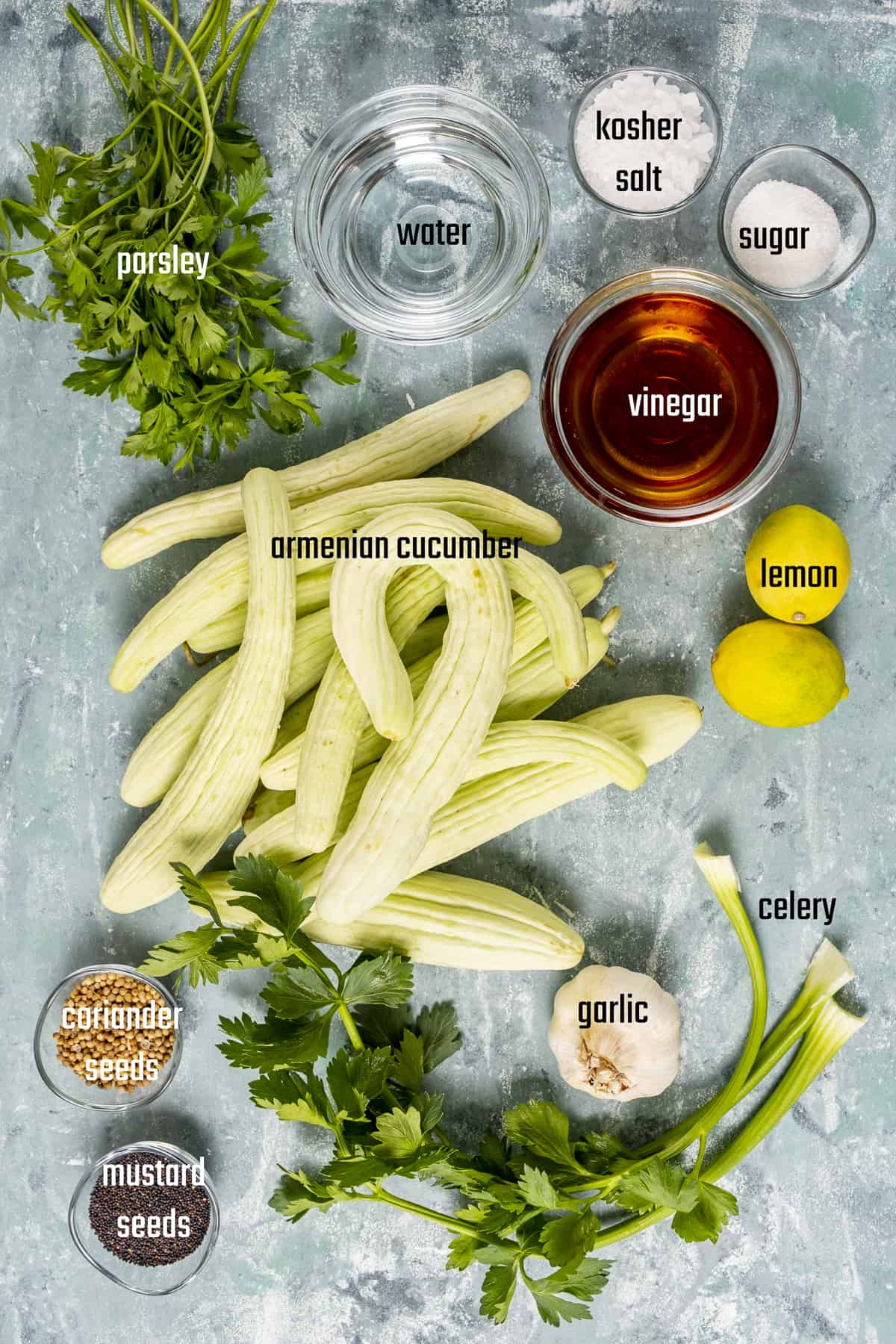
About The Ingredients
There are two important categories of ingredients for this recipe. The first is the pickle and the second is the brine.
Pickling: Armenian cucumbers are the hero ingredient for this recipe as we love their texture. You can always substitute the Armenian cucumbers with regular cucumbers or other vegetables. We love making mixed pickles as the earthy flavors of the vegetables also blend beautifully.
Some of the easiest vegetables to pickle include carrots, gherkins, string beans, cauliflower, and radishes.
Brine: The brine itself has several components. It is still very versatile, but some ingredients will work better than others. Also check out our basic pickle brine recipe which can be used to make pickles from any vegetable.
First of all, you need to use kosher salt, not table salt. This salt doesn’t contain any anti-caking agents and therefore won’t hinder the pickling process. When using regular table salt, the cucumbers (and accompanying ingredients) won’t pickle.
Then, you also have to add sugar for a little bit of sweetness. It doesn't have to be a lot. But it helps create a more balanced flavor profile.
You can use almost any type of vinegar for the brine. Just make sure that you know what their differences are and how that will affect the overall flavor of your Armenian cucumber pickles.
White vinegar will give you a clean look. However, apple or grape vinegar will help add more flavor. You can try each and make your own decision. Just keep in mind that balsamic vinegar is not recommended when pickling.
Optional Add-Ins: The accompanying celery, garlic, spices, seeds and herbs are for additional flavor. You don't need to use them but they definitely enrich the overall flavor of the pickles. Also check out our homemade pickle spice!
You can play around with flavor by adding different spices and herbs. You can add dill seeds, celery seeds, black or red peppercorns, chilli flakes, red pepper flakes or even turmeric for some color. Instead of parsley, you can use fresh dill too.
How To Make It
These pickles are filled with refreshing tangy, sweet, and earthy flavors. And our technique leaves them with an uber-crunchy texture too! Now, let's learn the process of pickling Armenian cucumbers.
- Prepare the jars: You can use pint jars. To sterilize, wash the jars and their lids in the dishwasher using the hottest setting. Set them aside to cool. You don’t need sterilization if you are planning to eat them within 2 months but make sure to store them in the refrigerator.
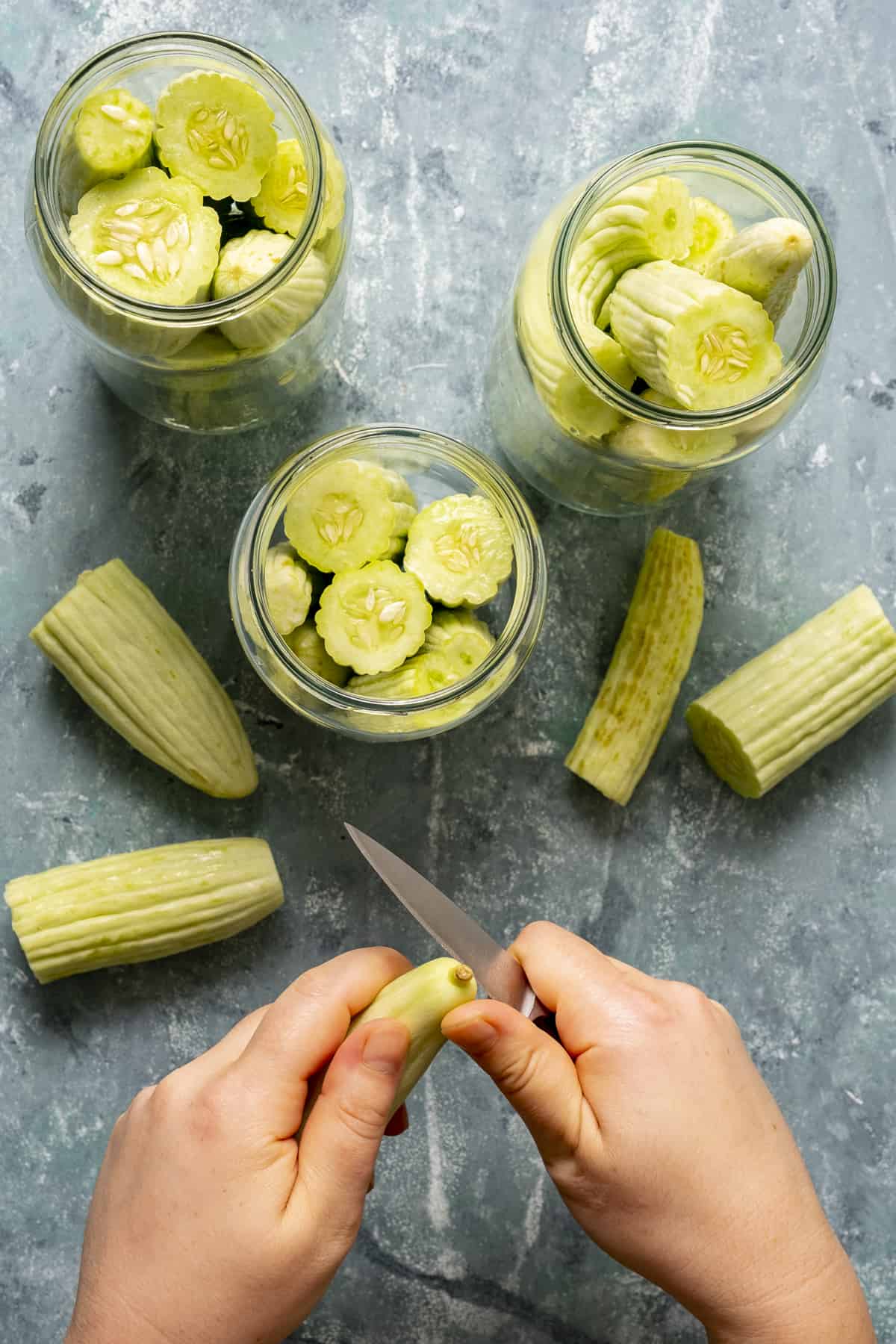
- Prepare the cucumbers: Wash your Armenian cucumbers very well and trim off their ends. Then, cut them into 2-3 pieces or in strips that will easily fit into the jar. You can even leave them whole if they are small enough.
Some pickling recipes tell you to make small holes on the cucumbers using a toothpick, but we think it's not necessary. The cucumbers already absorb the brine well as their ends are trimmed.
- Make the brine: Dissolve the salt and sugar in hot water. Add the vinegar and lemon juice and give the mixture a good stir. Let it cool.
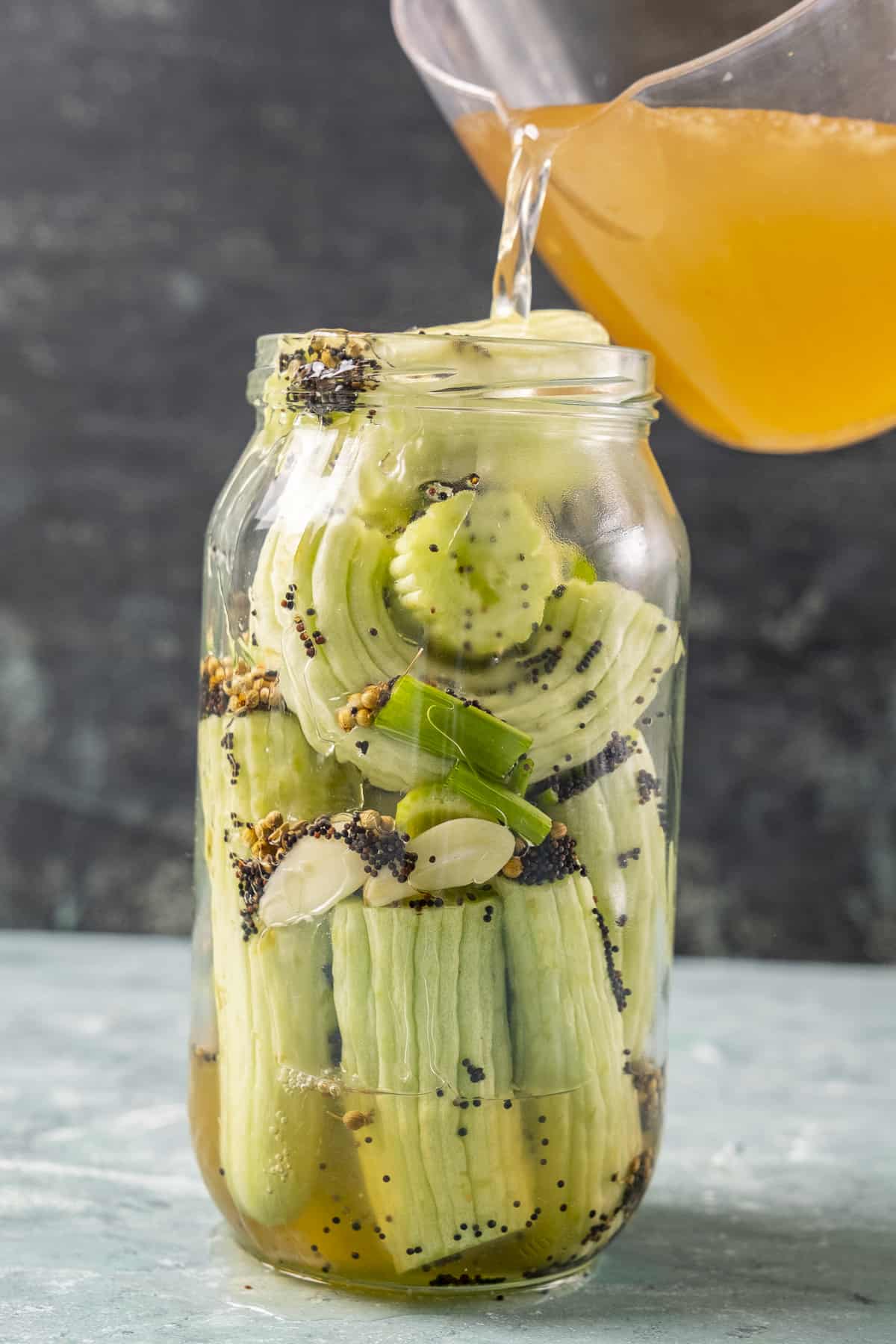
- Assemble: Place the prepared cucumbers, celery, and garlic inside the sterilized jars. Sprinkle the mustard and coriander seeds over the ingredients. Then, divide the brine liquid equally between the three jars. While doing this, fill half of each jar first and then continue filling the rest. If the brine is not enough to fill your jars, add filtered water into the jars to fill them up.
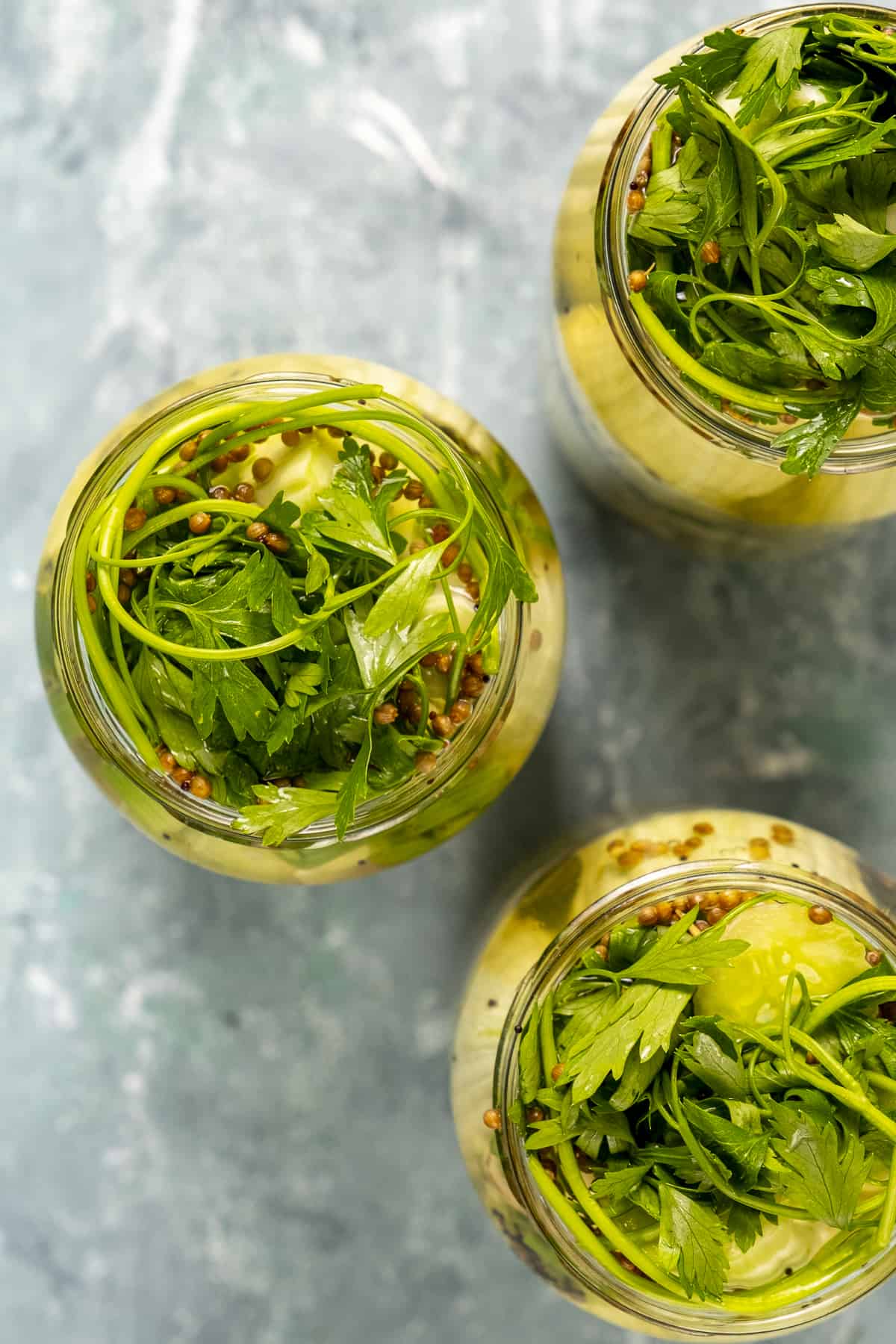
Add the parsley stalks on top of the jar to add flavor and keep the cucumbers from floating. Push them into the jars using the back of a spoon.
Don’t use your hands after pouring the brine in the jars. This might cause bacteria. Make sure everything is well coated with the brine. Tap the jars against the counter a few times to release the air bubbles.
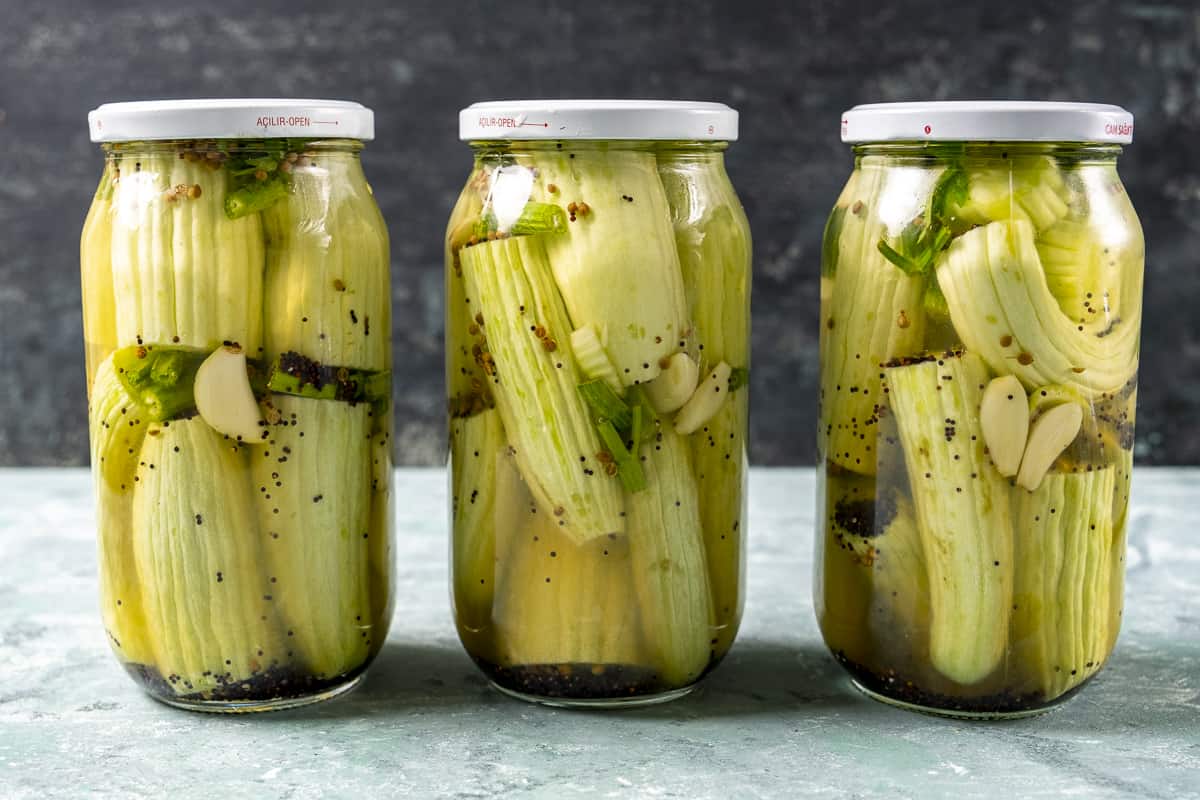
- Fermentation: Fill a small resealable freezer bag with a little water and put it on the top to weigh everything down. This is to prevent the cucumbers from being exposed to air. Cover the jars with the lids but not tightly. Leave the jars on the counter for two days. They might overflow during this time. It is ok. You can put each jar in a bowl.
On the second day, if there is any brine around the jars, clean them with a paper towel. Tighten the lids and store the jars in a cool and dry place that is away from sunlight. Your pickles are ready after 10-15 days.
- Storage: Store your pickles unopened in a cool place like your basement for a year. Unscrew the lids to release any gas “burp your jars” every few weeks. Keep them in the refrigerator after opening.
Variations
This pickle recipe requires fermentation. So you have to wait for 10-15 days before enjoying them.
To make quick pickles with no fermentation process: Combine all the ingredients for brine in a pan and heat this mixture just until it boils. Let it cool for about 10 minutes and pour it over the cucumbers in the jar when it is still warm.
Let them sit on the counter until they reach the room temperature. Tighten the lids and keep them in the refrigerator. You can eat them after 24 hours. They are tastier after 48 hours. They should keep well for 4-6 weeks.

Tips
- You can use 3 quart-size jars to make this recipe.
- If you leave out lemon juice, use 1:1 ratio for water and vinegar.
- If you want them sweeter, add ¼ cup of sugar. You can always taste the brine when it is warm and make adjustments about the amounts of vinegar, salt and sugar. Make sure not to dip the spoon in the brine again after tasting it though.
- If somehow the amount of brine is not enough, you can easily make another batch using the same ratio. Alternatively, you can use filtered water to fill the jars up after dividing the brine into each.
- You need to weigh the cucumbers down so that they always remain in the brine liquid. This is important for a perfect pickling and fermentation. You can do this by filling a small resealable freezer bag with a little water and putting it on the top of jars before placing the lids. Alternatively, you can even use a large stone that will fit in the jar. Just place it on the top of everything in the jars and then tighten the lids.
- If you see the brine is cloudy, it is ok.
- Always use a spoon or fork to get pickles from the jar. Don’t use your hands. It causes bad bacteria when your hand touches the brine, which leads to mold.
What Dishes To Serve With It
Some stews that work well with these pickles specifically include the Turkish white bean stew and a hearty meatball stew. You can even try our Tavuklu Pilav, Turkish beef stew or lamb stew called kuzu guvec.
The fresh tangy flavors and crunchy textures of the cucumbers help break very savory flavors. That’s why they pair so well together.
And, if you want to incorporate them into a salad, our first choices would be grain-based options. You have to try this bulgur salad, buckwheat salad, and wheat salad first. They are all extremely filling and flavorful as-is. But, with some added pickles, they’ll be elevated even further!
Now, all that being said, the best way to eat pickled Armenian cucumbers are as-is with a flavorful dip or spread. This is the best way to truly experience their delicious flavor and crunchy texture.
FAQs
Of course! The fantastic thing about bread and butter pickles is that you can virtually use any type of cucumber. The only difference between it and regularly used varieties is the size and shape.
These cucumbers are rarely peeled as they have very thin skin. We don’t peel them to make pickles either. Just like traditional cucumbers, you can keep their skins on for all recipes. There is no reason that cucumbers need their skins removed other than personal preference.
More Pickle Recipes
Other Preserving Recipes
As always: If you make this recipe, let us know what you think by rating it and leaving a comment below. And post a pic on Instagram too—tag @give_recipe so we can see!
Sign up for the FREE GiveRecipe Newsletter to get the new recipes into your inbox! And stay in touch with us on Facebook, Pinterest, YouTube and Instagram for all the latest updates.
📖 Recipe

Armenian Cucumber Pickles Recipe
INGREDIENTS
Pickling:
- 4 lbs Armenian cucumbers
- 3 stalks celery cut into small pieces
- 1 head garlic peeled
- 3 tablespoons mustard seeds
- 3 tablespoons coriander seeds
- ½ bunch parsley or dill
Pickle Brine:
- 3½ tablespoons kosher salt
- 1 tablespoon sugar
- 3 cups water boiling hot
- 2½ cups vinegar white vinegar, apple vinegar, grape vinegar are all ok
- 2 large lemons juice only, optional (If you leave it out, then use equal ratio of water and vinegar)
INSTRUCTIONS
- Prepare the jars: To sterilize, wash the jars and their lids in the dishwasher using the hottest setting. You don’t need sterilization if you are planning to eat them within 2 months but make sure to store them in the refrigerator.
- Prepare the cucumbers: Wash the Armenian cucumbers well and cut their top stems off. Cut the cucumbers in 2 or 3 depending on their size. If they are small enough and they can fit in the jars, leave them whole. Alternatively, you can slice them in stripes.
- Make the brine: Dissolve salt and sugar in hot water. Add in vinegar and lemon juice.
- Assemble: Place the prepared cucumbers, celery, and garlic inside the sterilized jars. Sprinkle the mustard and coriander seeds over the ingredients. Then, divide the brine liquid equally between the three jars. While doing this, fill half of each jar first and then continue filling the rest. If the brine is not enough to fill your jars, add filtered water into the jars to fill them up. Place parsley with their stalks on top of each jar. This is both for flavor and to prevent the cucumbers from floating. Push them into the jars using the back of a spoon. Don’t use your hands after pouring the brine in the jars. This might cause bacteria. Make sure everything is well coated with the brine. Tap the jars against the counter a few times to release the air bubbles.
- Fermentation: Fill a small resealable freezer bag with a little water and put it on the top to weigh everything down. This is to prevent them from being exposed to air. Cover the jars with the lids but not tightly. Leave the jars on the counter for two days. They might overflow during this time. It is ok. You can put each jar in a bowl. On the second day, if there is any brine around the jars, clean them with a paper towel. Tighten the lids and store the jars in a cool and dry place that is away from sunlight. Your pickles are ready after 10-15 days.
- Storage: Store your pickles unopened in a cool place like your basement for a year. Unscrew the lids to release any gas “burp your jars” every few weeks. Keep them in the refrigerator after opening.
NOTES
- Brine variation: If you leave out lemon juice, use 1:1 ratio for water and vinegar. We use little sugar and these pickles are really tangy. If you want them sweeter, add ¼ cup of sugar. You can always taste the brine when it is warm and make adjustments about the amounts of vinegar, salt and sugar. Make sure not to dip the spoon in the brine again after tasting it though. If somehow the amount of brine is not enough, you can easily make another batch using the same ratio.
- Add more vegetables: If you want mixed vegetable pickles, you can add vegetables like cucumbers, asparagus, green beans or carrots in the same jars.
- Storage: You can use 3 quart-size jars. If you see the brine is cloudy, it is ok. Always use a spoon or fork to get pickles from the jar. Don’t use your hands. It causes bad bacteria when your hand touches the brine, which leads to mold.
- To make quick pickles with no fermentation process: Combine all the ingredients for brine in a pan and heat this mixture just until it boils. Let it cool for about 10 minutes and pour it over the cucumbers in the jar when it is still warm.
- Let them sit on the counter until they reach room temperature. Tighten the lids and keep them in the refrigerator. You can eat them after 24 hours. They are tastier after 48 hours. They should keep well for 4-6 weeks.
NUTRITION
Nutrition information is automatically calculated, so should only be used as an approximation.
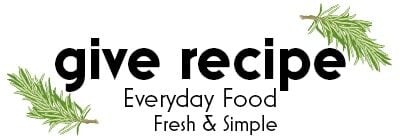

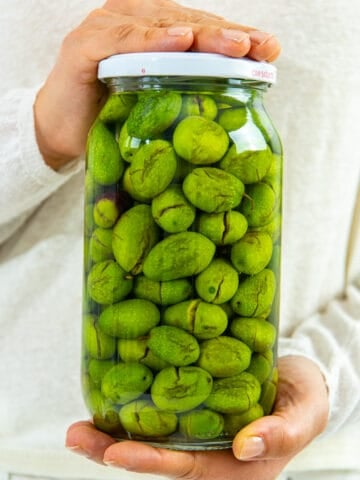
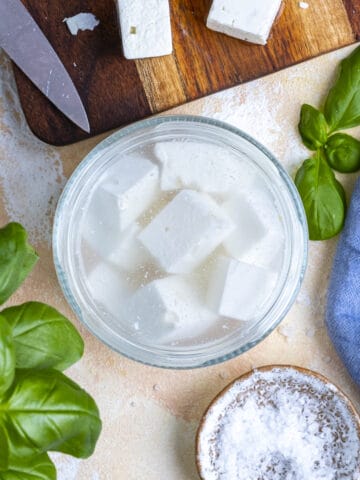
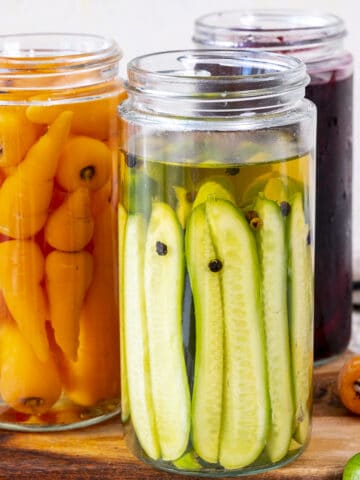

Maria says
I live in Crete where these cucumbers are a favorite, grown in summer and are quite abundant. I found this recipe and decided to give it a try with the only variation being that I added a few celery stalks to the jars and used the celery leaves on top instead of parsley. The crunch and the flavor are amazing, recipe was easy to follow and all my friends, who I gave a jar to, will be making their own. Thanks for sharing!
Zerrin & Yusuf says
We are so happy to hear that you enjoyed the recipe. Adding celery stalks and using celery leaves sound brilliant!
Donna Vogelpohl says
Just a short note - Armenian cucumbers are not cucumbers - they are melons - that taste like cucumbers. FYI from a lady who likes to garden and grows both.
Doug Wilke says
I don't have access to Grape Vinegar. Would apple cider vinegar be a good substitute?
Yusuf says
Hi Doug,
I would go with white vinegar. Although apple cider vinegar works fine, it might darken the vegetables.
Raylin says
How long will these keep in on the shelf after fermenting? What temperature should they be kept at after fermenting?